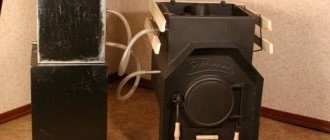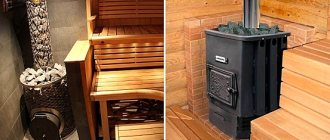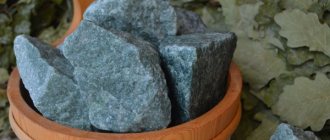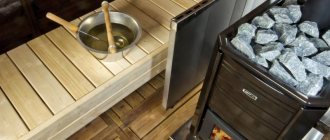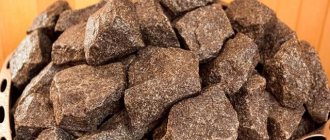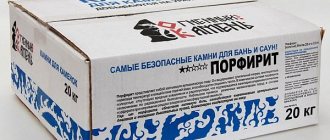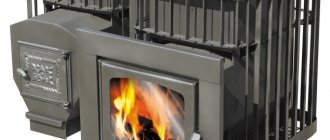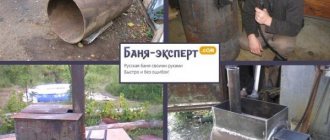heating a barrel sauna
If you have already read articles on this site about a barrel sauna, which I am the owner of, you will have noticed that almost the only disadvantage of a barrel sauna is that it cools down quickly - in the morning it is already cold in a sauna that has been heated in the evening.
The solution is to line the stove with brick or stone. Anyone can modernize a barrel bath in this way with their own hands in a short time. And to lay such a stove you need a couple of dozen bricks, a little clay and sand. And just an hour of work and you have a super sauna stove!
Why do you need a stove lining at all? And is there any benefit from it?
The fact is that a stove made of sheet metal has many positive properties, these are:
- The light weight of the furnace structure does not require a foundation;
- Sufficient service life of the furnace;
- Maintainability;
- Mobility (possibility of replacement);
- Very fast heating of the room;
- Easy to install yourself.
But it has disadvantages:
- A metal stove does not retain heat well;
- The surface of the stove becomes very hot during combustion (the risk of getting burned is great! I personally suffered from a terrible accident!!!).
To eliminate these phenomena, brick walls are usually laid around the metal structure.
As a result, the stove receives new very positive properties of the stove, and there are many of them:
- When burning fuel, a metal stove quickly heats up and gives off heat. As soon as the fire in the stove goes out, the stove quickly cools down and the temperature in the room drops. The bricks surrounding the surface of the furnace heat up and, unlike metal, release thermal energy slowly. Lining the stove with brick maintains a comfortable temperature in the room or steam room of the bath longer.
- If, when lining the stove, the walls are raised slightly higher than the top edge of the sauna stove, then you can increase the number of stones for steam without fear that they will fly off, as if they were piled high.
- When fuel burns, the metal becomes so hot that touching it can cause severe burns. The surface of the brick does not heat up to such a high temperature. We increase safety!
- The heat from the heating device becomes softer and more evenly distributed throughout the room or steam room. We get more pleasure from the vaping process!
- Brick gives the stove an attractive appearance. Look at photos on the Internet or use your imagination and a brick will help you turn a simple stove into a decorative element that decorates the interior.
- The brick shell seems to “breathe”. During the heating process, moisture from the brick evaporates into the room, and during cooling it is absorbed back. As a result, the microclimate improves - the air will not be too dry or too humid. There is no dampness or mold in the room and steam room with a brick stove.
Why does the bathhouse cool down quickly?
Every bathhouse owner dreams of improving their bathhouse. There are many materials available on the market now. Figuring out which insulation to choose for a bath or sauna is not easy. Often, sales consultants do not delve into the essence of the process of insulating a bathhouse.
Every bathhouse owner dreams of improving their bathhouse. There are many materials available on the market now. Figuring out which insulation to choose for a bath or sauna is not easy. Often, sales consultants do not delve into the essence of the process of insulating a bathhouse. What is the bathhouse made of? What is the task? Let's try to look at these questions.
There are 3 types of baths common in Russia
Brick/Concrete Wooden Frame-panel
Peculiarities
Brick/Concrete
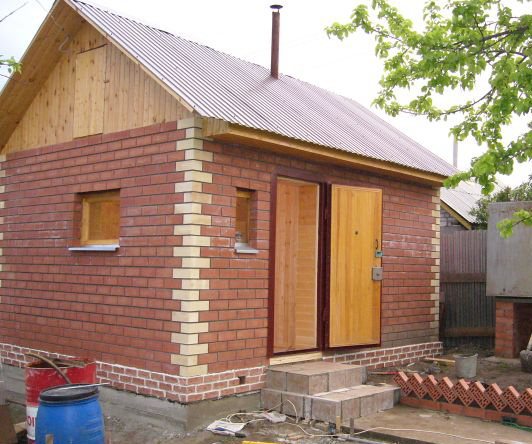
Wooden
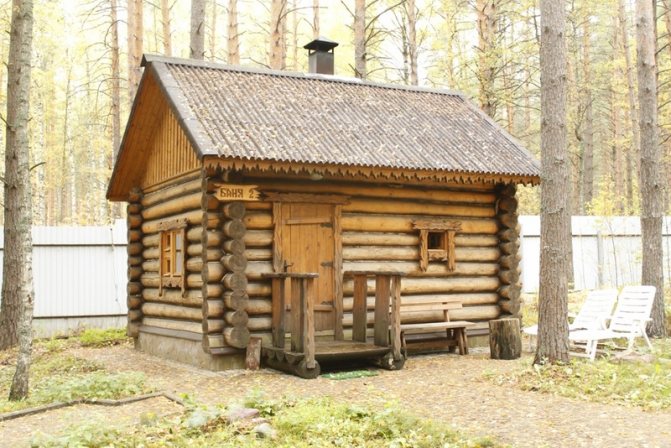
- Heats up relatively quickly
- Keeps warm well
Frame-panel
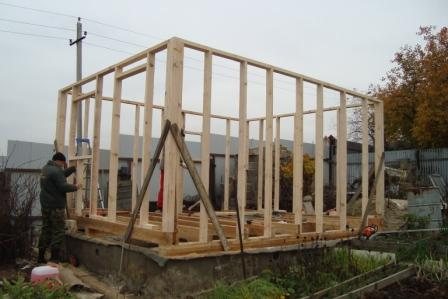
- Heats up quickly
- Cools down quickly
An important point is that all these types differ in heat capacity.
Those. – walls accumulate heat for varying amounts of time.
BUT WHY DO WE ACCUMULATE HEAT IN THE BATH?!
In the bath you need short-term HEAT, quickly and a lot!
The stove in the sauna provides a lot of heat, but all this heat is spent on heating the sauna itself. Warming up the entire structure - walls, ceiling, foundation and even the attic. Remember that feeling of icy walls in a bathhouse in winter?
How does all this happen!?
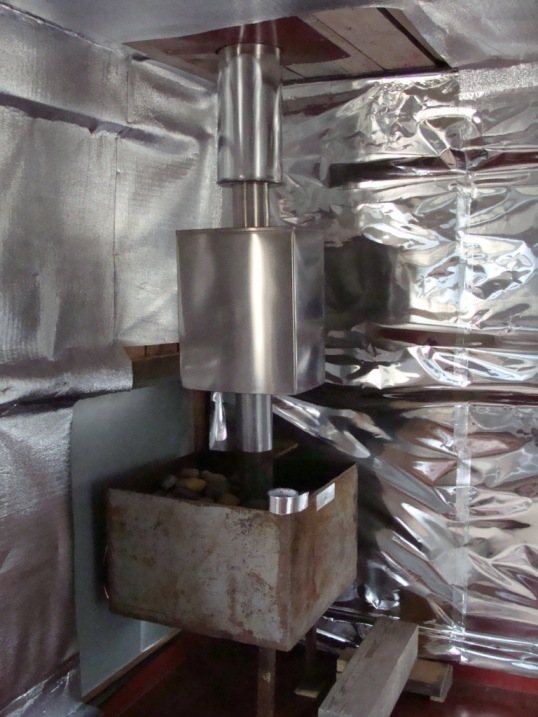
There is a lot of heat from the stove and it begins to warm up the warm air around it, but the walls are cold and they, in turn, cool this air. The frost presses on the walls from the outside and freezes them.
Thus, the stove heats the air and begins to warm up the walls, and until the walls warm up to the very outside, there will be no heat in the bathhouse.
Why do we waste time and wood to heat the entire bathhouse?!
We don’t have a task - to spend the night in a heated bath!?
And the warmth will remain in the walls for a very long time after we leave the bathhouse.
The notorious dew point will move in the wall from the inside to the outside and back again after freezing.
What do we get by installing reflective insulation in a bathhouse?!
We put a barrier between cold and heat.
A barrier – which returns 95% of the heat to the bathhouse.
The heat reflected from the insulation accumulates in the lining and it is already a heat-intensive material in the bathhouse, it holds the heat.
Let's remember the greenhouse - we go into the greenhouse after a cold night and it's warm there!
The heat source in the greenhouse is the earth, moist steam transfers heat well, the film locks the heat inside well, because greenhouse film is 100% vapor-proof.
How to line a stove. Instructions. Rules.
The first is brick . Ordinary solid hardened ceramic bricks are better suited. They do not place it on a cement mixture, which cracks from the heat, but on a sand-clay mixture .
Secondly , when laying, leave holes for ventilation of the metal of the stove . Otherwise, the brick-lined stove will quickly burn out and become unusable. Ventilation holes are usually made at the bottom of the masonry and sometimes leaving gaps between the bricks. When laying bricks, they can fit quite tightly to the walls of the furnace, but there is no need to put putty between them.
Third , if the purpose of the lining is also safety , but covering the front wall of the furnace completely with brick is impractical, the masonry should be made so that the side walls extend slightly forward.
Covering technology - Instructions.
What you need to pay attention to:
- A gap of 1 to 10 cm is left between the metal surface and the masonry for air circulation;
- For the movement of convection currents that quickly heat the room, holes (vents) are left in the masonry; they are made at least two at the top of the masonry and two at the bottom, on the side walls;
- When lining the front wall with doors, you need to make sure that the brick does not interfere with their opening;
- Remove any mortar that comes out of the joints immediately before it dries.
LITERALLY THESE DAYS I WILL POST MY AUTHOR'S VIDEO ON MY LINED STOVE IN A BARREL BATH. VISIT THE PAGE. In the meantime, a draft version for testing - but even this has an effect:
An accessory such as a thermo-inductive fan heater, which drives heated air from the stove to the side, has proven itself quite well in heating a bath, thereby increasing the circulation of hot air throughout the room and warming it up faster.
All the interesting purchases that I tried - I save the links here, you can also use them.

The fan heater itself can be bought here for INEXPENSIVE https://ali.pub/44ly1s, and now the other day new models of such fans appeared on aliexpress that are attached directly to the pipe - just a bomb, I already ordered HERE https://ali.pub/ 4cbsgz, I’ll post here when it arrives, take a look at this site, add it to your bookmarks so as not to lose it)))
Well, for better performance of the fan heater, I recommend immediately taking thermal paste https://ali.pub/4po5oo, it costs a penny and delivery is free.
Rules for proper steam in the bathhouse
1. The heat from the wood should be uniform. This can be achieved by choosing the right firewood. You can find out which firewood produces uniform heat here and here. In addition, the firewood should not be large.
2. During combustion, the upper damper should be kept open at all times.
3. The lower one can be kept either open or closed, depending on what is required at the moment (closed keeps heat, open keeps traction).
4. After the firewood has burned out and the bathhouse has warmed up (this takes at least 4 hours), the room is disinfected. To do this, steam is applied. These measures will help the room warm up faster.
5. When applying water to the stones, try to pour it over all the stones, not just some part.
6. Know when to stop. You should not pour water over the stones - this will end your washing.
7. 300-400 ml of water should be poured onto the stones at a time. This is enough to create light steam.
8. Hissing water on the stones indicates their cooling. Really hot stones instantly turn all the water into steam.
9. After the steam rises to the ceiling, it should be dispersed with a broom.
10. Steam is supplied with hot water often and in small portions.
If your ears begin to burn, then the steam is not being delivered correctly. In this case, you should reduce the amount of water in the ladle.
Visiting the bathhouse is a centuries-old Russian tradition, which should not be abandoned even in the warm season. Doing this in summer is even more beneficial than in winter, experts say. We talk about the rules for visiting a bathhouse in the heat.
In hot weather, toxins are more actively eliminated through the skin.
And as a result, metabolites, dead cells, and dust accumulate on its surface in excess. This explosive mixture does not allow her to breathe normally. Yes, yes, in addition to pulmonary breathing, we also have cutaneous breathing! Regular visits to the bathhouse (including in the heat) promote deep cleansing of all layers of the epidermis. And we feel energetic and cheerful. Even the summer heat is much easier to bear. A bathhouse in the heat: how it differs from a winter steam bath.
The features here are more likely related to our feelings and mood, which, of course, are influenced by the time of year.
In winter, you want to warm up properly in a hot, very hot steam room, so that the desire to plunge into snow or an ice bath is caused by the body’s natural need to cool down. In the off-season, when it’s uncomfortable, chilly and damp outside, we dream of plunging into the warmth and basking in it. Accordingly, vaping takes place mostly in simmering mode, comfortable deep heating with a soft contrast. In the hot summer, the body itself asks for frequent changes in temperature and contrasts. Therefore, steaming sessions are shorter, alternating with frequent trips to the cool plunge pool. Bathhouse in the heat: rules for steaming
There are no special rules here. The optimal vaping mode for each person is chosen individually. For beginners, gradual immersion is recommended. Without the habit of staying in a hot steam room for a long time, it is difficult, and it is not necessary. Little by little, the body, heart, and blood vessels train and become more resilient. Accordingly, you can increase the residence time and temperature in the steam room. The psychological state should also be taken into account: after all, every time we come to the bathhouse in a different mood, and if we don’t particularly want to steam, we may physically tolerate the procedure worse. The mode, temperature and time of vaping will depend on this too.
As for frequency, visiting the bathhouse once a week is enough, as our ancestors did. This is the optimal mode to cleanse the body and provide yourself with a powerful energy boost for the weekly cycle.
Otherwise, when visiting the bathhouse, it is recommended to adhere to the following recommendations.
— Adapt to the high temperature by sitting in the waiting room.
Then make a short run for 2-3 minutes at a temperature of no higher than 85°C. This is enough to open the skin pores. In subsequent visits, you can use a broom.
— Maintain drinking regime.
In the bath we lose a large amount of water. Take hot herbal tea or rosehip drink with you. Quench your thirst after steaming, and if you visit the sauna, drink a glass of tea before entering the steam room.
— Don’t forget about contrast procedures
. If you want to spend the maximum detox in the bathhouse, be sure to douse yourself with steaming water at room temperature afterward. Such a procedure will narrow the capillaries of the skin, but will expand the vessels carrying blood to the liver and kidneys - this will activate the cleansing processes. But for those losing weight, it is better to exclude contrast procedures; they reduce sweating.
— Take care of your own safety
. It is easy to catch any infection in the steam room. Therefore, do not forget to bring rubber slippers to the bathhouse, and treat your feet with a special antibacterial gel. Never sit on a shelf without a towel. To prevent urogenital infections, you can use special sprays for intimate care, for example, based on chlorhexidine.
— Do not apply masks and creams directly in the steam room.
Cosmetics made from natural ingredients often contain a lot of essential oils, which can cause skin burns. Products from jars often contain artificial ingredients - dyes, flavors and preservatives, which can interact with each other when heated. The result of the reaction can be a chemical cocktail that is unsafe for the skin.
— Put aside creams and body milk
.
Do not rush to apply them immediately after the bath. The skin should breathe a little after the steam room. All of the above cosmetics form a film on it that blocks the access of oxygen. Also, substances contained in cosmetics can cause rapid contamination of pores. Wait 3-4 hours, and then use your usual facial and body care. Bathhouse in the heat: what to take with you
When going to the bathhouse in the summer, take with you what we cannot afford at other times of the year. For example, fresh nettles. If you pour boiling water over it, the sting will disappear, and you will have a wonderful natural washcloth. Seasonal fruits, berries, vegetables and herbs can be used to make wonderful face masks. But body scrubs made from honey and salt, as well as masks made from medicinal clay and mud, are classics of bath culture and are always appropriate. Few are among the experts on using essential oils in summer. At this time, the aromas of real herbs are enough. These herbs should be taken with you while you have the opportunity. By adding oils, we strengthen and direct the energy-informational impact on the psyche. For example, in winter, when there is not enough sun, we try to compensate for its deficiency with citrus essential oils in order to lift our mood and feel a surge of energy and joy. In summer, what the blooming nature provides is quite enough.
And, of course, when going to the bathhouse, don’t forget about the broom. Traditionally it is made from oak or birch branches. This broom is more practical because after use it quickly restores its shape and can withstand more than one soar. In summer you can afford more variety. According to our expert, a wonderful broom for going to the bathhouse can be made from the branches of aspen, rowan, hazel and delicate linden.
They are collected and prepared after the holiday of the Great Trinity. In addition to a broom for active work, it would be nice to have another one to cover your head. Collect it from your favorite fragrant plants - flowering shrubs, field herbs that do not cause you allergies. Jasmine, bird cherry, lilac, young shoots of black currant and raspberry are suitable. Herbs include sweet clover, fireweed, mint.
